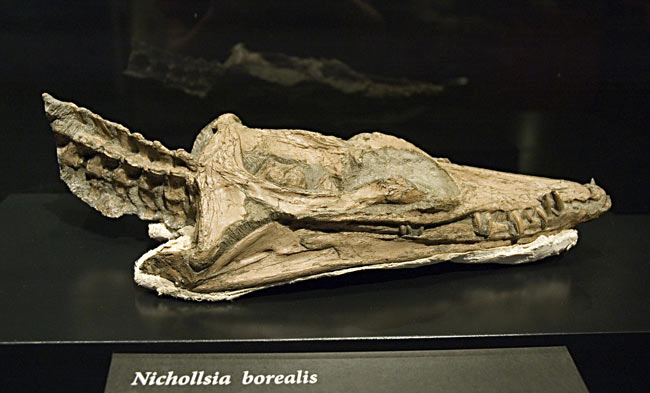Oldest Prehistoric Aquatic Reptile in North America Found

One of the oldest and most complete skeletons of a prehistoric aquatic reptile in North America has been uncovered, representing an entirely new group of these plesiosaurs, paleontologists say. Plesiosaurs are not classified as dinosaurs, but these reptiles swam in the seas at the same time that dinosaurs roamed the land throughout the Jurassic and Cretaceous Periods (about 205 million to 65 million years ago). The new specimen is an 8.5-foot (2.6-meter)-long plesiosaur named Nichollsia borealis in memory of the late renowned paleontologist Elizabeth (Betsy) Nicholls. Nicholls was credited with transforming the understanding of prehistoric ocean life by describing the largest-ever marine reptile, a 76-foot (23-meter)-long ichthyosaur, discovered in northern British Columbia in 1999. Plesiosaurs were a diverse group of aquatic carnivores that reached lengths of over 39 feet (12 meters). Nichollsia lived about 112 million years ago, and the specimen fills in a 40-million-year gap in the plesiosaur fossil record. The fossil was discovered by machine operators in a Syncrude Canada Ltd. mine in the northeastern part of Alberta, Canada, in 1994. The description of the fossil was not published until now because fossils take a long time to prepare; the rock they were embeded in must be removed before they can be properly studied.
"Some fossils take years and years to get prepped," said researcher Patrick Druckenmiller, a former University of Calgary graduate student. University of Calgary researchers studied and formally described the newly announced plesiosaur specimen in the current issue of the German research journal Palaeontographica Abteilung A.
"This is a great tribute because Betsy worked on many of the fossils recovered by Syncrude over the years, and this specimen is a direct result of the connection she had with the company for many years," said Nicholl's husband, Jim Nicholls, a retired University of Calgary professor. "We are very proud that her work will be remembered in the scientific record in this way." The fossil was uncovered by one of Syncrude's 100-ton electric shovels about 197 feet (60 meters) below the surface of the ground. The skeleton was complete except for its left forelimb and shoulder blade, making it one of the most complete and best-preserved North American plesiosaurs from the Cretaceous Period. "This specimen was preserved in sandstone and was not crushed as much as most specimens, which have typically been found in shale," Druckenmiller said. "Because of this I was able to have its three-dimensional skull CT-scanned so we can see the details of the insides of its braincase. This has helped us understand this animal in more detail than almost any other plesiosaur ever found." The discovery of Nichollsia could improve scientists' understanding of the ancient seaway that once divided North America in two. "This individual was a pioneer in the marine waters that would eventually become the Cretaceous Western Interior Seaway, which ran the length of North America during much of the Cretaceous and was home to one of the world's most diverse communities of marine reptiles," Druckenmiller, said. "It represents the oldest known forerunner of this amazing period in North American history."
Several fossils of other types of plesiosaur and a few ichthyosaurs were also found in the same rock bed, some also representing previously unknown species. These marine beasts would have swam in the same seaway as Nichollsia, Druckenmiller told LiveScience.
"They were probably seeing each other in the same ocean," he said.
The Nichollsia specimen is currently on display in the Discoveries Gallery at the Royal Tyrrell Museum in Alberta.
- Video: Plesiosaur in Action
- A Brief History of Dinosaurs
- Images: Dinosaur Fossils
Sign up for the Live Science daily newsletter now
Get the world’s most fascinating discoveries delivered straight to your inbox.

Andrea Thompson is an associate editor at Scientific American, where she covers sustainability, energy and the environment. Prior to that, she was a senior writer covering climate science at Climate Central and a reporter and editor at Live Science, where she primarily covered Earth science and the environment. She holds a graduate degree in science health and environmental reporting from New York University, as well as a bachelor of science and and masters of science in atmospheric chemistry from the Georgia Institute of Technology.










